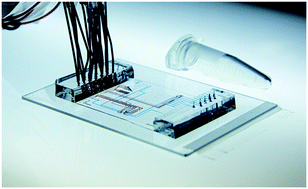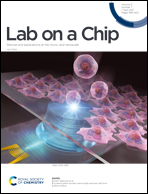Paper-thin multilayer microfluidic devices with integrated valves†
Abstract
Integrated valve microfluidics has an unparalleled capability to automate rapid delivery of fluids at the nanoliter scale for high-throughput biological experimentation. However, multilayer soft lithography, which is used to fabricate valve-microfluidics, produces devices with a minimum thickness of around five millimeters. This form-factor limitation prevents the use of such devices in experiments with limited sample thickness tolerance such as 4-pi microscopy, stimulated Raman scattering microscopy, and many forms of optical or magnetic tweezer applications. We present a new generation of integrated valve microfluidic devices that are less than 300 μm thick, including the cover-glass substrate, that resolves the thickness limitation. This “thin-chip” was fabricated through a novel soft-lithography technique that produces on-chip micro-valves with the same functionality and reliability of traditional thick valve-microfluidic devices despite the orders of magnitude reduction in thickness. We demonstrated the advantage of using our thin-chip over traditional thick devices to automate fluid control while imaging on a high-resolution inverted microscope. First, we demonstrate that the thin-chip provides an improved signal to noise when imaging single cells with two-color stimulated Raman scattering (SRS). We then demonstrated how the thin-chip can be used to simultaneously perform on-chip magnetic manipulation of beads and fluorescent imaging. This study reveals the potential of our thin-chip in high-resolution imaging, sorting, and bead capture-based single-cell multi-omics applications.



 Please wait while we load your content...
Please wait while we load your content...